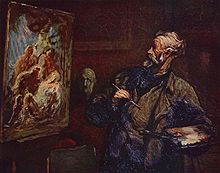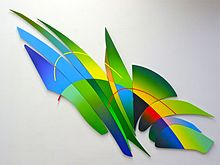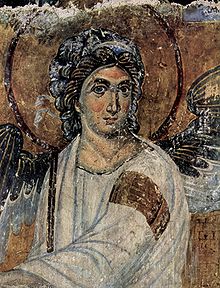User:OnBeyondZebrax/sandbox/Painting
| This is not a Wikipedia article: It is an individual user's work-in-progress page, and may be incomplete and/or unreliable. For guidance on developing this draft, see Wikipedia:So you made a userspace draft. Find sources: Google (books · news · scholar · free images · WP refs) · FENS · JSTOR · TWL |
The oldest known paintings are at about 32,000 years old. They are engraved and painted using
In Western cultures
The invention of photography had a major impact on painting. In the decades after the first
Among the continuing and current directions in painting at the beginning of the 21st century are
Aesthetics and theory
Hegel recognized the failure of attaining a universal concept of beauty and in his aesthetic essay wrote that Painting is one of the three "romantic" arts, along with Poetry and Music for its symbolic, highly intellectual purpose.[3][4] Painters who have written theoretical works on painting include
In 1890, the Parisian painter Maurice Denis famously asserted: "Remember that a painting—before being a warhorse, a naked woman or some story or other—is essentially a flat surface covered with colors assembled in a certain order."[7] Thus, many 20th-century developments in painting, such as Cubism, were reflections on the means of painting rather than on the external world, nature, which had previously been its core subject. Recent contributions to thinking about painting have been offered by the painter and writer Julian Bell. In his book What is Painting?, Bell discusses the development, through history, of the notion that paintings can express feelings and ideas.[8] In Mirror of The World Bell writes:
A work of art seeks to hold your attention and keep it fixed: a history of art urges it onwards, bulldozing a highway through the homes of the imagination.[9]
Painting media

Different types of paint are usually identified by the medium that the pigment is suspended or embedded in, which determines the general working characteristics of the paint, such as viscosity, miscibility, solubility, drying time, etc.
Oil
Pastel
Pastel is a painting medium in the form of a stick, consisting of pure powdered pigment and a binder.[10] The pigments used in pastels are the same as those used to produce all colored art media, including oil paints; the binder is of a neutral hue and low saturation. The color effect of pastels is closer to the natural dry pigments than that of any other process.[11] Because the surface of a pastel painting is fragile and easily smudged, its preservation requires protective measures such as framing under glass; it may also be sprayed with a fixative. Nonetheless, when made with permanent pigments and properly cared for, a pastel painting may endure unchanged for centuries. Pastels are not susceptible, as are paintings made with a fluid medium, to the cracking and discoloration that result from changes in the color, opacity, or dimensions of the medium as it dries.
Acrylic

Acrylic paint is fast drying paint containing pigment suspension in acrylic polymer emulsion. Acrylic paints can be diluted with water, but become water-resistant when dry. Depending on how much the paint is diluted (with water) or modified with acrylic gels, media, or pastes, the finished acrylic painting can resemble a watercolor or an oil painting, or have its own unique characteristics not attainable with other media. The main practical difference between most acrylics and oil paints is the inherent drying time. Oils allow for more time to blend colors and apply even glazes over under-paintings. This slow drying aspect of oil can be seen as an advantage for certain techniques, but in other regards it impedes the artist trying to work quickly.
Watercolor
Ink
Ink paintings are done with a liquid that contains pigments and/or
Hot wax

Fresco
Fresco is any of several related mural painting types, done on plaster on walls or ceilings. The word fresco comes from the Italian word affresco [afˈfresːko], which derives from the Latin word for fresh. Frescoes were often made during the Renaissance and other early time periods. to attach the pigment to the wall.

Gouache
Gouache is a water based paint consisting of pigment and other materials designed to be used in an opaque painting method. Gouache differs from watercolor in that the particles are larger, the ratio of pigment to water is much higher, and an additional, inert, white pigment such as chalk is also present. This makes gouache heavier and more opaque, with greater reflective qualities. Like all watermedia, it is diluted with water.[12]
Enamel
Enamels are made by painting a substrate, typically metal, with frit, a type of powdered glass. Minerals called color oxides provide coloration. After firing at a temperature of 750–850 degrees Celsius (1380–1560 degrees Fahrenheit), the result is a fused lamination of glass and metal. Enamels have traditionally been used for decoration of precious objects,[13] but have also been used for other purposes. In the 18th century, enamel painting enjoyed a vogue in Europe, especially as a medium for portrait miniatures.[14] In the late 20th century, the technique of porcelain enamel on metal has been used as a durable medium for outdoor murals.[15]
Spray paint
Speed, portability and permanence also make aerosol paint a common graffiti medium. In the late 1970s, street graffiti writers' signatures and murals became more elaborate and a unique style developed as a factor of the aerosol medium and the speed required for illicit work. Many now recognize graffiti and street art as a unique art form and specifically manufactured aerosol paints are made for the graffiti artist. A stencil protects a surface, except the specific shape to be painted. Stencils can be purchased as movable letters, ordered as professionally cut logos or hand-cut by artists.
Tempera
Tempera, also known as egg tempera, is a permanent, fast-drying painting medium consisting of colored pigment mixed with a water-soluble binder medium (usually a glutinous material such as egg yolk or some other size). Tempera also refers to the paintings done in this medium. Tempera paintings are very long lasting, and examples from the first centuries AD still exist. Egg tempera was a primary method of painting until after 1500 when it was superseded by the invention of oil painting. A paint commonly called tempera (though it is not) consisting of pigment and glue size is commonly used and referred to by some manufacturers in America as poster paint.
Water miscible oil paint
Water miscible oil paints (also called "water soluble" or "water-mixable") is a modern variety of oil paint engineered to be thinned and cleaned up with water, rather than having to use chemicals such as turpentine. It can be mixed and applied using the same techniques as traditional oil-based paint, but while still wet it can be effectively removed from brushes, palettes, and rags with ordinary soap and water. Its water solubility comes from the use of an oil medium in which one end of the molecule has been altered to bind loosely to water molecules, as in a solution.
Painting styles
Style is used in two senses: It can refer to the distinctive visual elements, techniques and methods that typify an individual artist's work. It can also refer to the movement or school that an artist is associated with. This can stem from an actual group that the artist was consciously involved with or it can be a category in which art historians have placed the painter. The word 'style' in the latter sense has fallen out of favor in academic discussions about contemporary painting, though it continues to be used in popular contexts. Such movements or classifications include the following:
Western
Modernism
modernism in painting was impressionism, a school of painting that initially focused outdoor painting
Abstract painting uses a visual language of form, color and line to create a composition that may exist with a degree of independence from visual references in the world.
Outsider art is "raw art" or "rough art" created outside the boundaries of official culture. Photorealism paintings are very realistic like a photograph.
- ^ "How Old is Australia's Rock Art?". Aboriginalartonline.com. Retrieved 2014-03-13.
- ISBN 812690187X
- ^ Craig, Edward. Routledge Encyclopedia of Philosophy: Genealogy to Iqbal, page 278. Routledge, 1998. Books.google.com. Retrieved 2014-03-13.
- ^ "Painting and music are the specially romantic arts. Lastly, as a union of painting and music comes poetry, where the sensuous element is more than ever subordinate to the spirit." Excerpted from Encyclopædia Britannica 1911
- ^ Marcel Franciscono Paul Klee: His Work and Thought, part 6 'The Bauhaus and Düsseldorf', chap. 'Klee's theory courses', p. 246 and under 'notes to pages 245–54' p.365
- ^ Moshe Barasch (2000) Theories of art – from impressionism to Kandinsky, part IV 'Abstract art', chap. 'Color' pp.332–3
- ^ Encyclopedia Encarta
- ^ "Review by art historian David Cohen". Artnet.com. Retrieved 2014-03-13.
- ISBN 9780500238370.
- ^ Mayer, Ralph,The Artist's Handbook of Materials and Techniques, Third Edition, New York: Viking, 1970, p. 312.
- ISBN 0-670-83701-6
- ^ Marjorie B. Cohn, Wash and Gouache, Fogg Museum, 1977.
- ^ Mayer, Ralph,The Artist's Handbook of Materials and Techniques, Third Edition, New York: Viking, 1970, p. 375.
- ^ McNally, Rika Smith, "Enamel", Oxford Art Online
- ^ Mayer, Ralph,The Artist's Handbook of Materials and Techniques, Third Edition, New York: Viking, 1970, p. 371.

